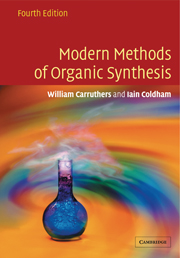Book contents
5 - Functionalization of alkenes
Published online by Cambridge University Press: 05 June 2012
Summary
Alkenes are very useful in synthesis, owing to their ready conversion to many different functional groups. As a result of their importance, Chapter 2 was devoted to methods for their preparation. You should have noticed that we have already encountered many reactions of alkenes. For example, nucleophilic additions (such as conjugate addition) and palladium-catalysed reactions are covered in Chapter 1, pericyclic reactions (such as the Diels–Alder reaction) are described in Chapter 3, and addition reactions with radicals and carbenes are given in Chapter 4. This chapter covers other functionalization reactions, including hydroboration, epoxidation, aziridination, dihydroxylation, oxidative cleavage and palladium-catalysed oxidation. Commonly, the carbon–carbon double bond is converted to a single bond with the incorporation of one or two heteroatoms at the original alkene carbon atom(s). Examples of the oxidation of alkenes are included here, whereas the oxidation of other functional groups are provided in Chapter 6. Reduction of alkenes are described in Chapter .
Hydroboration
Organoboranes are obtained by addition of borane or alkyl boranes to alkenes (or alkynes). Borane itself can be prepared by reaction of boron trifluoride etherate with sodium borohydride. Borane exists as a dimer, but solutions containing an electron donor, such as an ether, amine or sulfide, allow adduct formation. The complexes BH3·THF and the borane–dimethyl sulfide complex BH3·SMe2 are commercially available and provide a convenient source of borane.
- Type
- Chapter
- Information
- Modern Methods of Organic Synthesis , pp. 315 - 369Publisher: Cambridge University PressPrint publication year: 2004
- 2
- Cited by

